Evaluating Government Intervention for Macroeconomic Improvement
VerifiedAdded on 2023/06/14
|13
|2876
|161
Essay
AI Summary
This essay explores the ongoing debate on government intervention in market mechanisms, contrasting Keynesian demand management policies with classical economic views. It analyzes the impact of government intervention, using the AD-AS model to illustrate how demand management policies can stimulate economic growth, reduce inflation, and enhance employment. The essay also considers arguments against intervention, highlighting potential drawbacks such as reduced personal freedom and distorted market dynamics. Furthermore, it discusses the role of fiscal and monetary policies in improving macroeconomic scenarios, weighing their benefits and drawbacks. Ultimately, the essay concludes that, despite potential negative externalities, government intervention is essential for fostering economic growth and stability, safeguarding against market failures and promoting sustainable development.
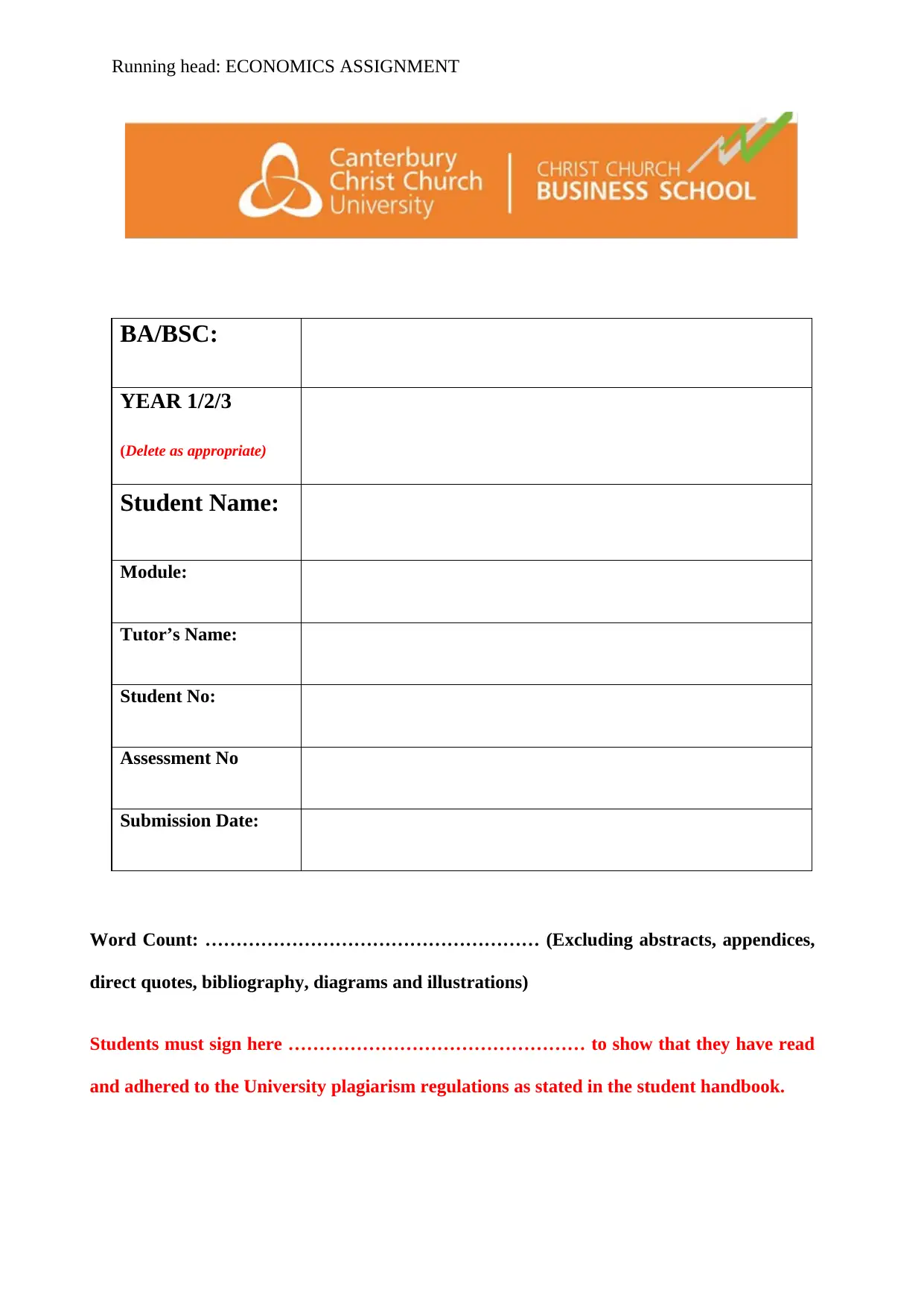
Running head: ECONOMICS ASSIGNMENT
BA/BSC:
YEAR 1/2/3
(Delete as appropriate)
Student Name:
Module:
Tutor’s Name:
Student No:
Assessment No
Submission Date:
Word Count: ……………………………………………… (Excluding abstracts, appendices,
direct quotes, bibliography, diagrams and illustrations)
Students must sign here ………………………………………… to show that they have read
and adhered to the University plagiarism regulations as stated in the student handbook.
BA/BSC:
YEAR 1/2/3
(Delete as appropriate)
Student Name:
Module:
Tutor’s Name:
Student No:
Assessment No
Submission Date:
Word Count: ……………………………………………… (Excluding abstracts, appendices,
direct quotes, bibliography, diagrams and illustrations)
Students must sign here ………………………………………… to show that they have read
and adhered to the University plagiarism regulations as stated in the student handbook.
Paraphrase This Document
Need a fresh take? Get an instant paraphrase of this document with our AI Paraphraser
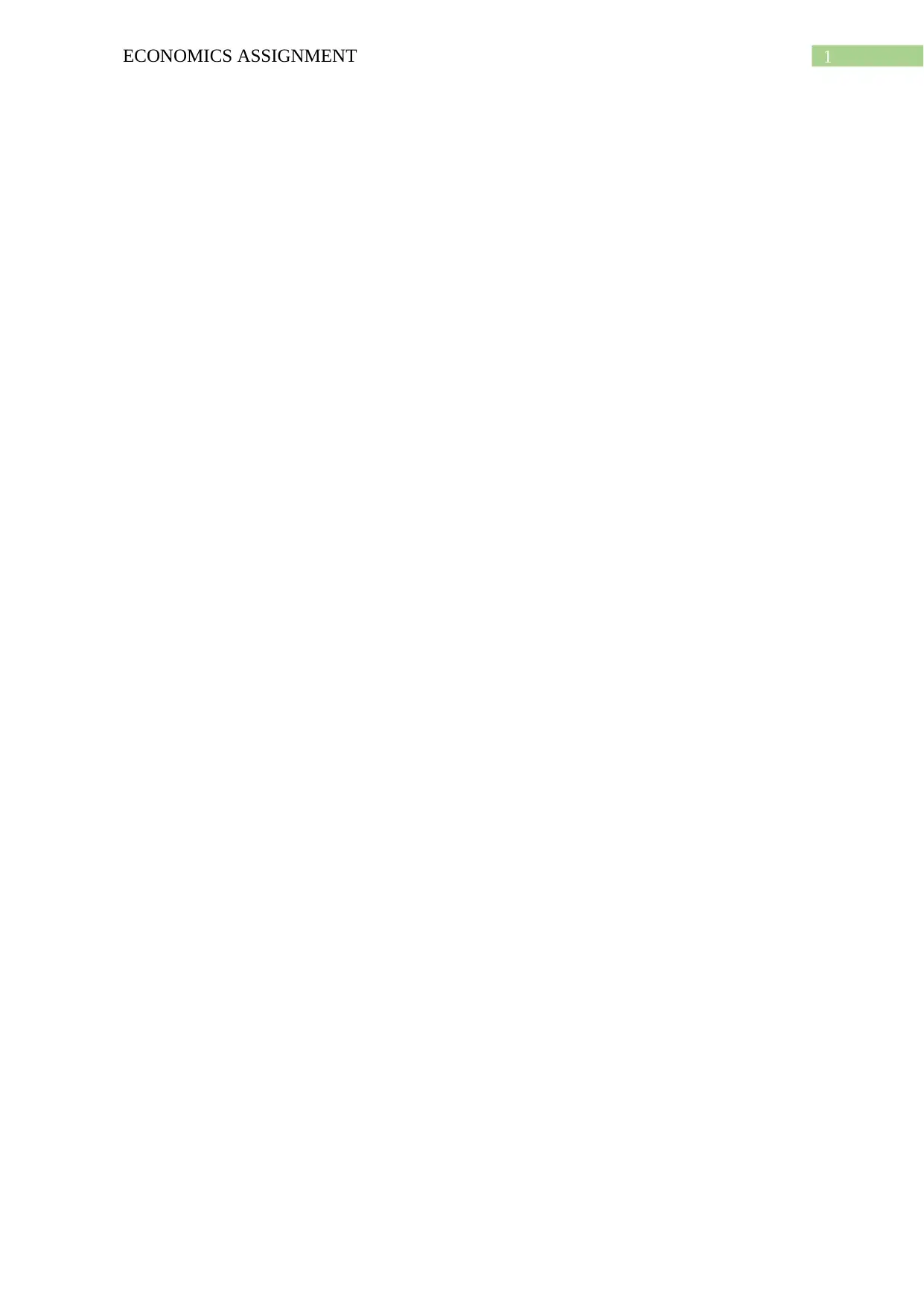
1ECONOMICS ASSIGNMENT
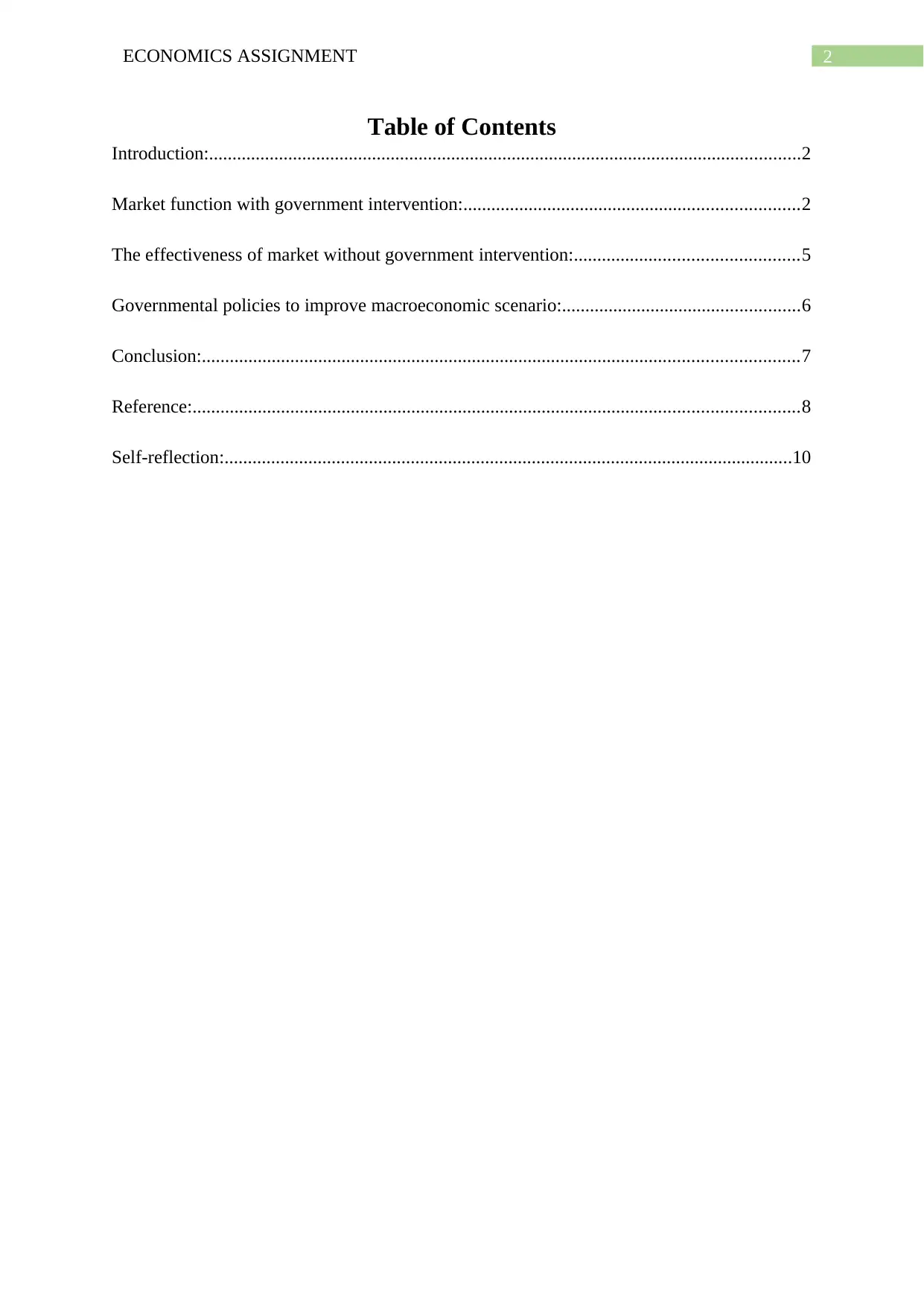
2ECONOMICS ASSIGNMENT
Table of Contents
Introduction:...............................................................................................................................2
Market function with government intervention:........................................................................2
The effectiveness of market without government intervention:................................................5
Governmental policies to improve macroeconomic scenario:...................................................6
Conclusion:................................................................................................................................7
Reference:..................................................................................................................................8
Self-reflection:..........................................................................................................................10
Table of Contents
Introduction:...............................................................................................................................2
Market function with government intervention:........................................................................2
The effectiveness of market without government intervention:................................................5
Governmental policies to improve macroeconomic scenario:...................................................6
Conclusion:................................................................................................................................7
Reference:..................................................................................................................................8
Self-reflection:..........................................................................................................................10
⊘ This is a preview!⊘
Do you want full access?
Subscribe today to unlock all pages.

Trusted by 1+ million students worldwide
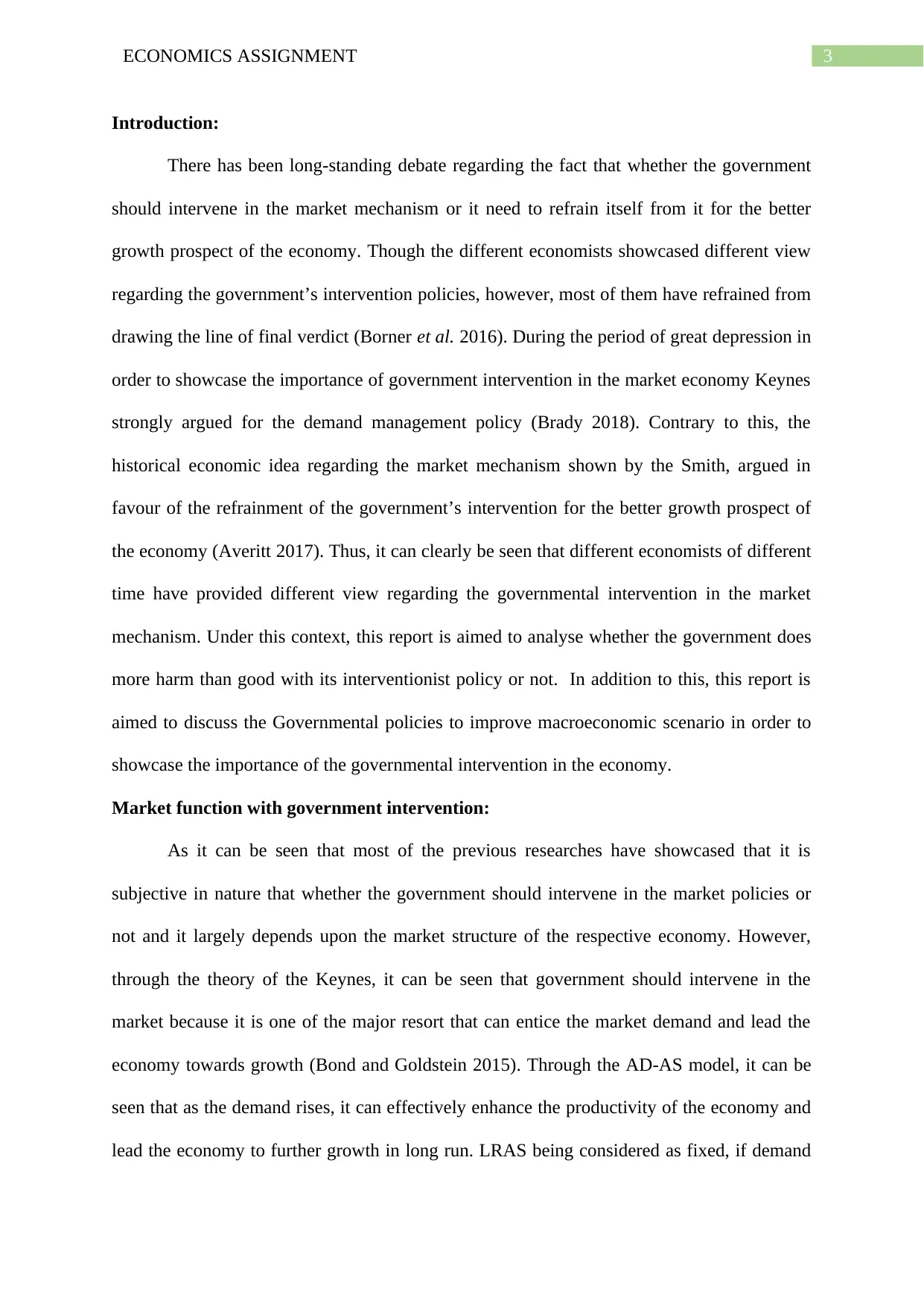
3ECONOMICS ASSIGNMENT
Introduction:
There has been long-standing debate regarding the fact that whether the government
should intervene in the market mechanism or it need to refrain itself from it for the better
growth prospect of the economy. Though the different economists showcased different view
regarding the government’s intervention policies, however, most of them have refrained from
drawing the line of final verdict (Borner et al. 2016). During the period of great depression in
order to showcase the importance of government intervention in the market economy Keynes
strongly argued for the demand management policy (Brady 2018). Contrary to this, the
historical economic idea regarding the market mechanism shown by the Smith, argued in
favour of the refrainment of the government’s intervention for the better growth prospect of
the economy (Averitt 2017). Thus, it can clearly be seen that different economists of different
time have provided different view regarding the governmental intervention in the market
mechanism. Under this context, this report is aimed to analyse whether the government does
more harm than good with its interventionist policy or not. In addition to this, this report is
aimed to discuss the Governmental policies to improve macroeconomic scenario in order to
showcase the importance of the governmental intervention in the economy.
Market function with government intervention:
As it can be seen that most of the previous researches have showcased that it is
subjective in nature that whether the government should intervene in the market policies or
not and it largely depends upon the market structure of the respective economy. However,
through the theory of the Keynes, it can be seen that government should intervene in the
market because it is one of the major resort that can entice the market demand and lead the
economy towards growth (Bond and Goldstein 2015). Through the AD-AS model, it can be
seen that as the demand rises, it can effectively enhance the productivity of the economy and
lead the economy to further growth in long run. LRAS being considered as fixed, if demand
Introduction:
There has been long-standing debate regarding the fact that whether the government
should intervene in the market mechanism or it need to refrain itself from it for the better
growth prospect of the economy. Though the different economists showcased different view
regarding the government’s intervention policies, however, most of them have refrained from
drawing the line of final verdict (Borner et al. 2016). During the period of great depression in
order to showcase the importance of government intervention in the market economy Keynes
strongly argued for the demand management policy (Brady 2018). Contrary to this, the
historical economic idea regarding the market mechanism shown by the Smith, argued in
favour of the refrainment of the government’s intervention for the better growth prospect of
the economy (Averitt 2017). Thus, it can clearly be seen that different economists of different
time have provided different view regarding the governmental intervention in the market
mechanism. Under this context, this report is aimed to analyse whether the government does
more harm than good with its interventionist policy or not. In addition to this, this report is
aimed to discuss the Governmental policies to improve macroeconomic scenario in order to
showcase the importance of the governmental intervention in the economy.
Market function with government intervention:
As it can be seen that most of the previous researches have showcased that it is
subjective in nature that whether the government should intervene in the market policies or
not and it largely depends upon the market structure of the respective economy. However,
through the theory of the Keynes, it can be seen that government should intervene in the
market because it is one of the major resort that can entice the market demand and lead the
economy towards growth (Bond and Goldstein 2015). Through the AD-AS model, it can be
seen that as the demand rises, it can effectively enhance the productivity of the economy and
lead the economy to further growth in long run. LRAS being considered as fixed, if demand
Paraphrase This Document
Need a fresh take? Get an instant paraphrase of this document with our AI Paraphraser
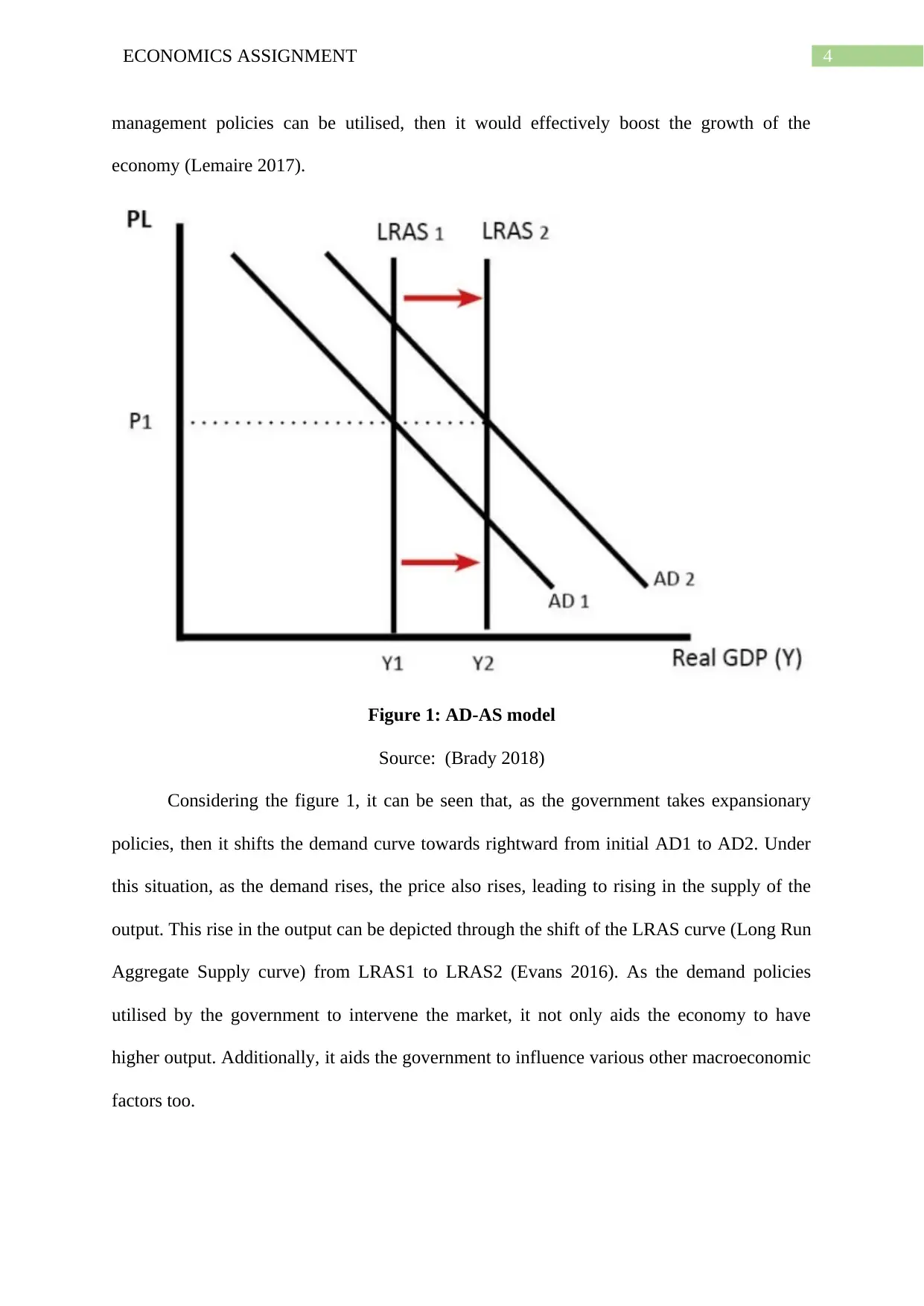
4ECONOMICS ASSIGNMENT
management policies can be utilised, then it would effectively boost the growth of the
economy (Lemaire 2017).
Figure 1: AD-AS model
Source: (Brady 2018)
Considering the figure 1, it can be seen that, as the government takes expansionary
policies, then it shifts the demand curve towards rightward from initial AD1 to AD2. Under
this situation, as the demand rises, the price also rises, leading to rising in the supply of the
output. This rise in the output can be depicted through the shift of the LRAS curve (Long Run
Aggregate Supply curve) from LRAS1 to LRAS2 (Evans 2016). As the demand policies
utilised by the government to intervene the market, it not only aids the economy to have
higher output. Additionally, it aids the government to influence various other macroeconomic
factors too.
management policies can be utilised, then it would effectively boost the growth of the
economy (Lemaire 2017).
Figure 1: AD-AS model
Source: (Brady 2018)
Considering the figure 1, it can be seen that, as the government takes expansionary
policies, then it shifts the demand curve towards rightward from initial AD1 to AD2. Under
this situation, as the demand rises, the price also rises, leading to rising in the supply of the
output. This rise in the output can be depicted through the shift of the LRAS curve (Long Run
Aggregate Supply curve) from LRAS1 to LRAS2 (Evans 2016). As the demand policies
utilised by the government to intervene the market, it not only aids the economy to have
higher output. Additionally, it aids the government to influence various other macroeconomic
factors too.
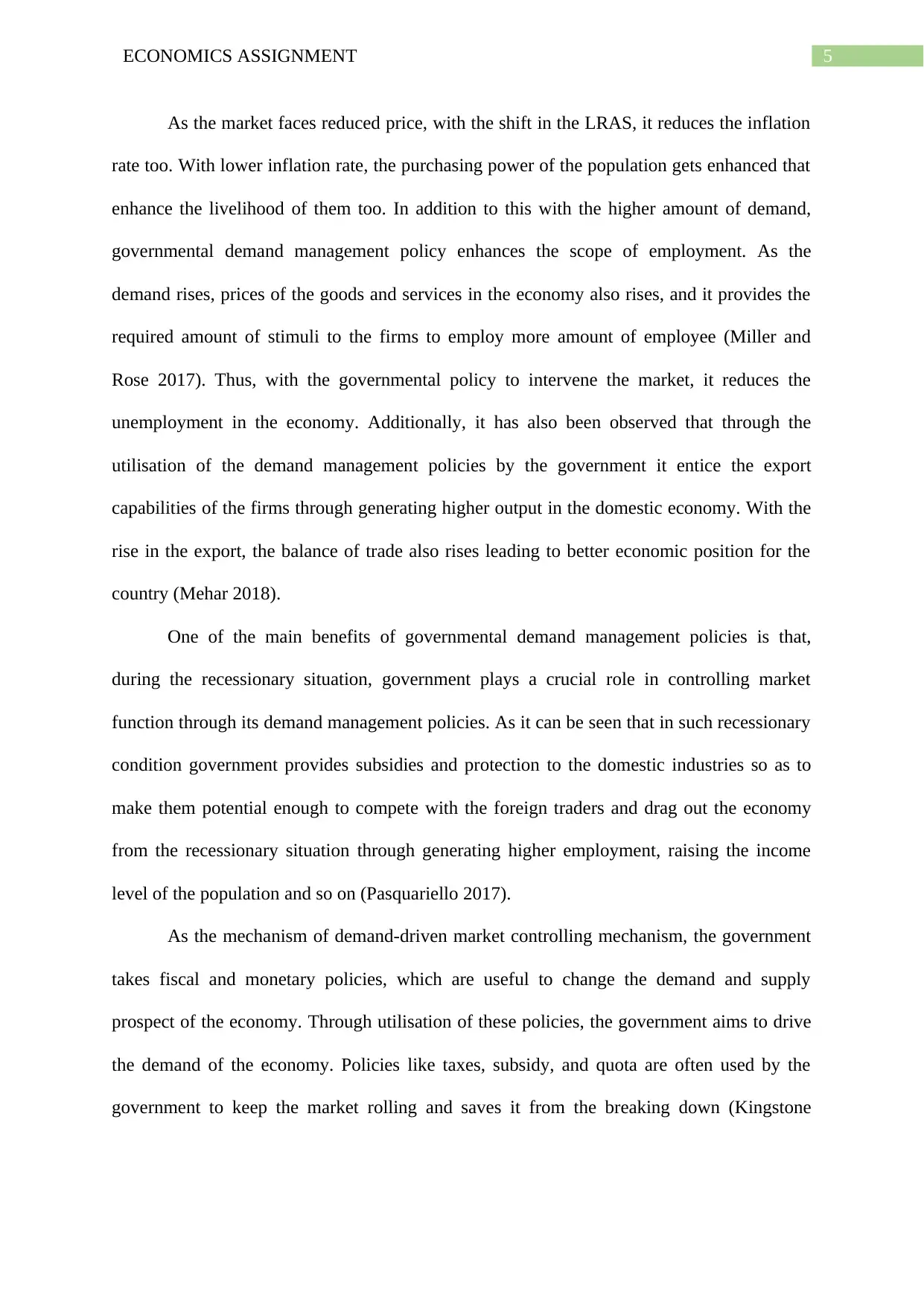
5ECONOMICS ASSIGNMENT
As the market faces reduced price, with the shift in the LRAS, it reduces the inflation
rate too. With lower inflation rate, the purchasing power of the population gets enhanced that
enhance the livelihood of them too. In addition to this with the higher amount of demand,
governmental demand management policy enhances the scope of employment. As the
demand rises, prices of the goods and services in the economy also rises, and it provides the
required amount of stimuli to the firms to employ more amount of employee (Miller and
Rose 2017). Thus, with the governmental policy to intervene the market, it reduces the
unemployment in the economy. Additionally, it has also been observed that through the
utilisation of the demand management policies by the government it entice the export
capabilities of the firms through generating higher output in the domestic economy. With the
rise in the export, the balance of trade also rises leading to better economic position for the
country (Mehar 2018).
One of the main benefits of governmental demand management policies is that,
during the recessionary situation, government plays a crucial role in controlling market
function through its demand management policies. As it can be seen that in such recessionary
condition government provides subsidies and protection to the domestic industries so as to
make them potential enough to compete with the foreign traders and drag out the economy
from the recessionary situation through generating higher employment, raising the income
level of the population and so on (Pasquariello 2017).
As the mechanism of demand-driven market controlling mechanism, the government
takes fiscal and monetary policies, which are useful to change the demand and supply
prospect of the economy. Through utilisation of these policies, the government aims to drive
the demand of the economy. Policies like taxes, subsidy, and quota are often used by the
government to keep the market rolling and saves it from the breaking down (Kingstone
As the market faces reduced price, with the shift in the LRAS, it reduces the inflation
rate too. With lower inflation rate, the purchasing power of the population gets enhanced that
enhance the livelihood of them too. In addition to this with the higher amount of demand,
governmental demand management policy enhances the scope of employment. As the
demand rises, prices of the goods and services in the economy also rises, and it provides the
required amount of stimuli to the firms to employ more amount of employee (Miller and
Rose 2017). Thus, with the governmental policy to intervene the market, it reduces the
unemployment in the economy. Additionally, it has also been observed that through the
utilisation of the demand management policies by the government it entice the export
capabilities of the firms through generating higher output in the domestic economy. With the
rise in the export, the balance of trade also rises leading to better economic position for the
country (Mehar 2018).
One of the main benefits of governmental demand management policies is that,
during the recessionary situation, government plays a crucial role in controlling market
function through its demand management policies. As it can be seen that in such recessionary
condition government provides subsidies and protection to the domestic industries so as to
make them potential enough to compete with the foreign traders and drag out the economy
from the recessionary situation through generating higher employment, raising the income
level of the population and so on (Pasquariello 2017).
As the mechanism of demand-driven market controlling mechanism, the government
takes fiscal and monetary policies, which are useful to change the demand and supply
prospect of the economy. Through utilisation of these policies, the government aims to drive
the demand of the economy. Policies like taxes, subsidy, and quota are often used by the
government to keep the market rolling and saves it from the breaking down (Kingstone
⊘ This is a preview!⊘
Do you want full access?
Subscribe today to unlock all pages.

Trusted by 1+ million students worldwide
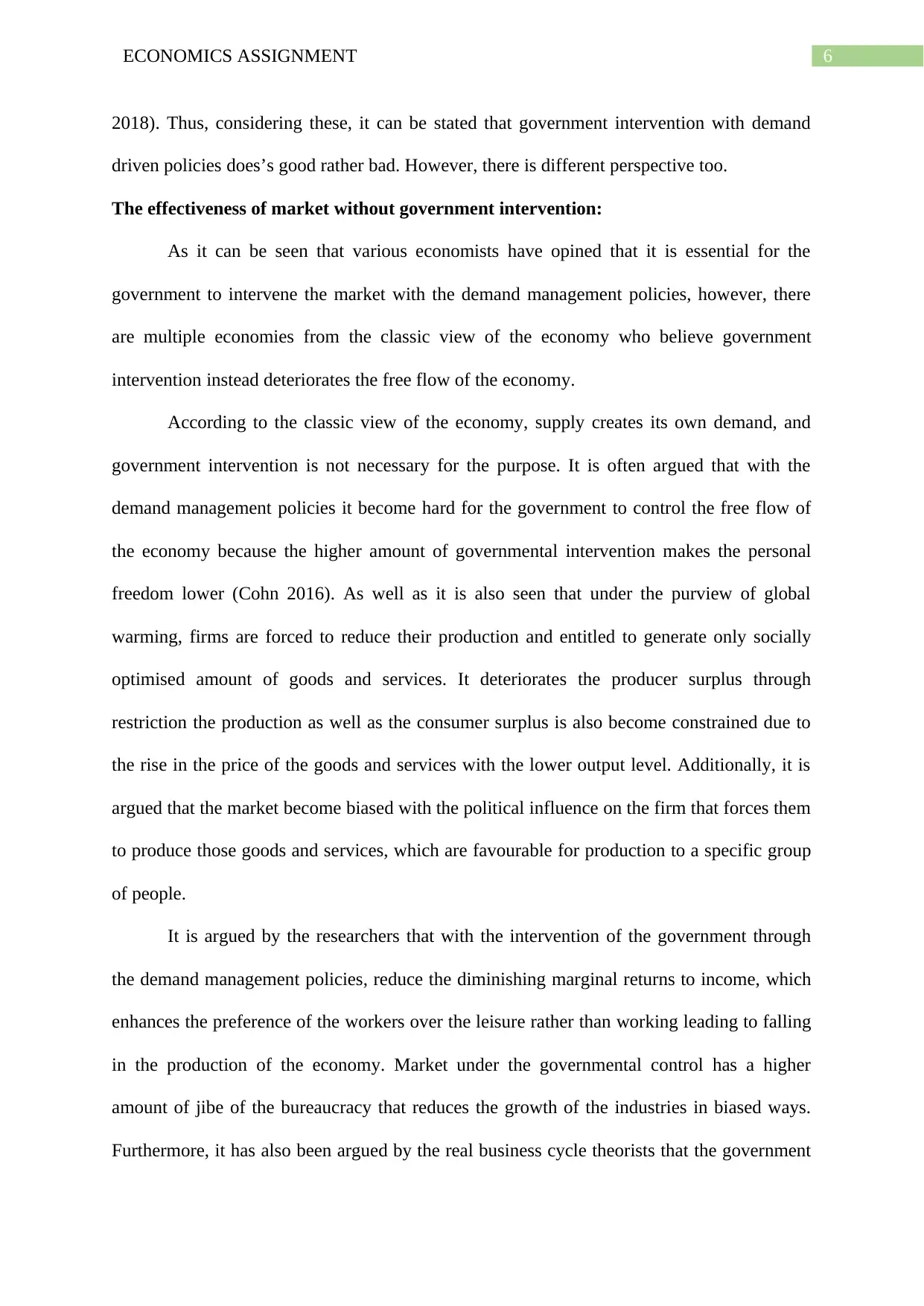
6ECONOMICS ASSIGNMENT
2018). Thus, considering these, it can be stated that government intervention with demand
driven policies does’s good rather bad. However, there is different perspective too.
The effectiveness of market without government intervention:
As it can be seen that various economists have opined that it is essential for the
government to intervene the market with the demand management policies, however, there
are multiple economies from the classic view of the economy who believe government
intervention instead deteriorates the free flow of the economy.
According to the classic view of the economy, supply creates its own demand, and
government intervention is not necessary for the purpose. It is often argued that with the
demand management policies it become hard for the government to control the free flow of
the economy because the higher amount of governmental intervention makes the personal
freedom lower (Cohn 2016). As well as it is also seen that under the purview of global
warming, firms are forced to reduce their production and entitled to generate only socially
optimised amount of goods and services. It deteriorates the producer surplus through
restriction the production as well as the consumer surplus is also become constrained due to
the rise in the price of the goods and services with the lower output level. Additionally, it is
argued that the market become biased with the political influence on the firm that forces them
to produce those goods and services, which are favourable for production to a specific group
of people.
It is argued by the researchers that with the intervention of the government through
the demand management policies, reduce the diminishing marginal returns to income, which
enhances the preference of the workers over the leisure rather than working leading to falling
in the production of the economy. Market under the governmental control has a higher
amount of jibe of the bureaucracy that reduces the growth of the industries in biased ways.
Furthermore, it has also been argued by the real business cycle theorists that the government
2018). Thus, considering these, it can be stated that government intervention with demand
driven policies does’s good rather bad. However, there is different perspective too.
The effectiveness of market without government intervention:
As it can be seen that various economists have opined that it is essential for the
government to intervene the market with the demand management policies, however, there
are multiple economies from the classic view of the economy who believe government
intervention instead deteriorates the free flow of the economy.
According to the classic view of the economy, supply creates its own demand, and
government intervention is not necessary for the purpose. It is often argued that with the
demand management policies it become hard for the government to control the free flow of
the economy because the higher amount of governmental intervention makes the personal
freedom lower (Cohn 2016). As well as it is also seen that under the purview of global
warming, firms are forced to reduce their production and entitled to generate only socially
optimised amount of goods and services. It deteriorates the producer surplus through
restriction the production as well as the consumer surplus is also become constrained due to
the rise in the price of the goods and services with the lower output level. Additionally, it is
argued that the market become biased with the political influence on the firm that forces them
to produce those goods and services, which are favourable for production to a specific group
of people.
It is argued by the researchers that with the intervention of the government through
the demand management policies, reduce the diminishing marginal returns to income, which
enhances the preference of the workers over the leisure rather than working leading to falling
in the production of the economy. Market under the governmental control has a higher
amount of jibe of the bureaucracy that reduces the growth of the industries in biased ways.
Furthermore, it has also been argued by the real business cycle theorists that the government
Paraphrase This Document
Need a fresh take? Get an instant paraphrase of this document with our AI Paraphraser
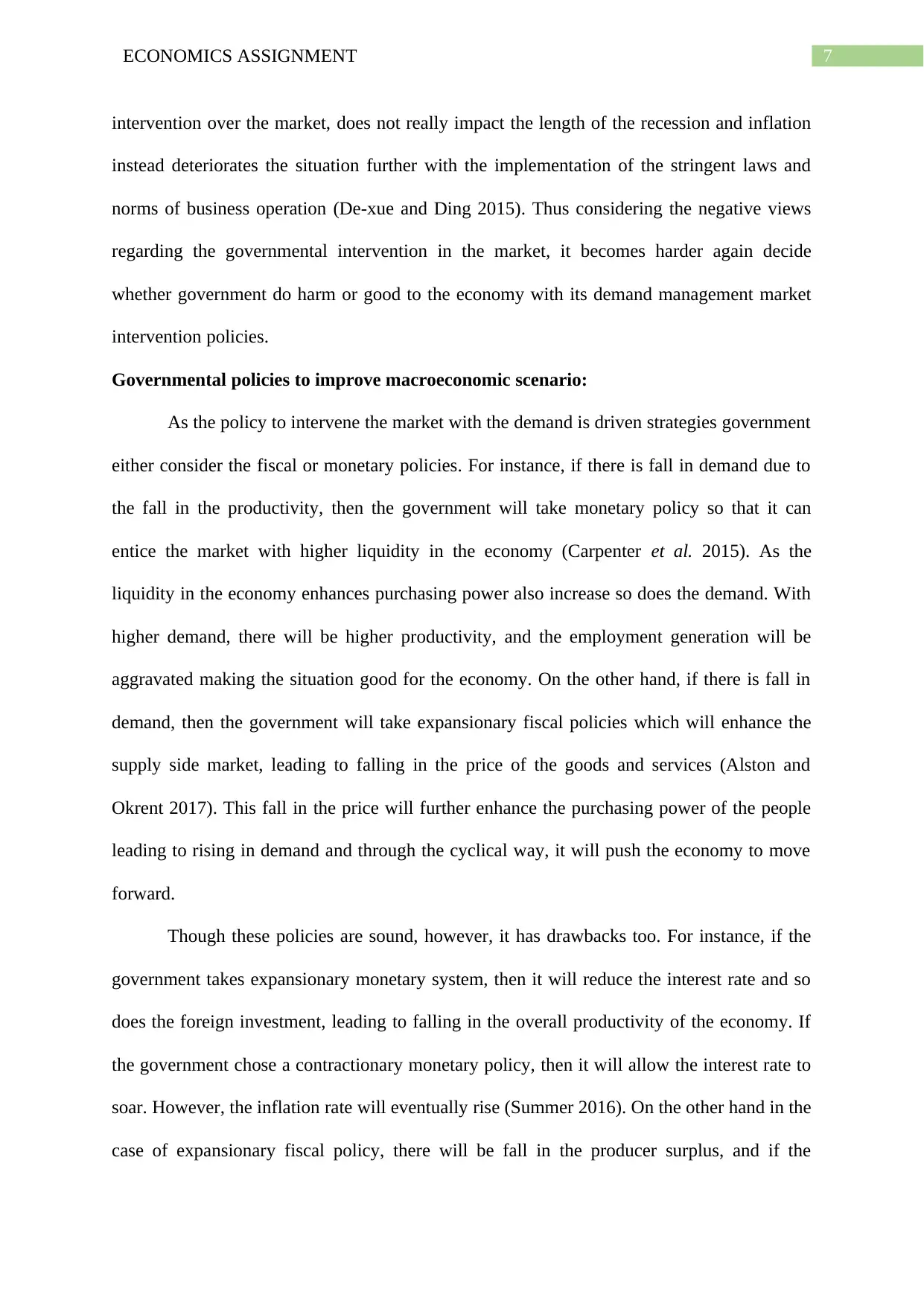
7ECONOMICS ASSIGNMENT
intervention over the market, does not really impact the length of the recession and inflation
instead deteriorates the situation further with the implementation of the stringent laws and
norms of business operation (De-xue and Ding 2015). Thus considering the negative views
regarding the governmental intervention in the market, it becomes harder again decide
whether government do harm or good to the economy with its demand management market
intervention policies.
Governmental policies to improve macroeconomic scenario:
As the policy to intervene the market with the demand is driven strategies government
either consider the fiscal or monetary policies. For instance, if there is fall in demand due to
the fall in the productivity, then the government will take monetary policy so that it can
entice the market with higher liquidity in the economy (Carpenter et al. 2015). As the
liquidity in the economy enhances purchasing power also increase so does the demand. With
higher demand, there will be higher productivity, and the employment generation will be
aggravated making the situation good for the economy. On the other hand, if there is fall in
demand, then the government will take expansionary fiscal policies which will enhance the
supply side market, leading to falling in the price of the goods and services (Alston and
Okrent 2017). This fall in the price will further enhance the purchasing power of the people
leading to rising in demand and through the cyclical way, it will push the economy to move
forward.
Though these policies are sound, however, it has drawbacks too. For instance, if the
government takes expansionary monetary system, then it will reduce the interest rate and so
does the foreign investment, leading to falling in the overall productivity of the economy. If
the government chose a contractionary monetary policy, then it will allow the interest rate to
soar. However, the inflation rate will eventually rise (Summer 2016). On the other hand in the
case of expansionary fiscal policy, there will be fall in the producer surplus, and if the
intervention over the market, does not really impact the length of the recession and inflation
instead deteriorates the situation further with the implementation of the stringent laws and
norms of business operation (De-xue and Ding 2015). Thus considering the negative views
regarding the governmental intervention in the market, it becomes harder again decide
whether government do harm or good to the economy with its demand management market
intervention policies.
Governmental policies to improve macroeconomic scenario:
As the policy to intervene the market with the demand is driven strategies government
either consider the fiscal or monetary policies. For instance, if there is fall in demand due to
the fall in the productivity, then the government will take monetary policy so that it can
entice the market with higher liquidity in the economy (Carpenter et al. 2015). As the
liquidity in the economy enhances purchasing power also increase so does the demand. With
higher demand, there will be higher productivity, and the employment generation will be
aggravated making the situation good for the economy. On the other hand, if there is fall in
demand, then the government will take expansionary fiscal policies which will enhance the
supply side market, leading to falling in the price of the goods and services (Alston and
Okrent 2017). This fall in the price will further enhance the purchasing power of the people
leading to rising in demand and through the cyclical way, it will push the economy to move
forward.
Though these policies are sound, however, it has drawbacks too. For instance, if the
government takes expansionary monetary system, then it will reduce the interest rate and so
does the foreign investment, leading to falling in the overall productivity of the economy. If
the government chose a contractionary monetary policy, then it will allow the interest rate to
soar. However, the inflation rate will eventually rise (Summer 2016). On the other hand in the
case of expansionary fiscal policy, there will be fall in the producer surplus, and if the
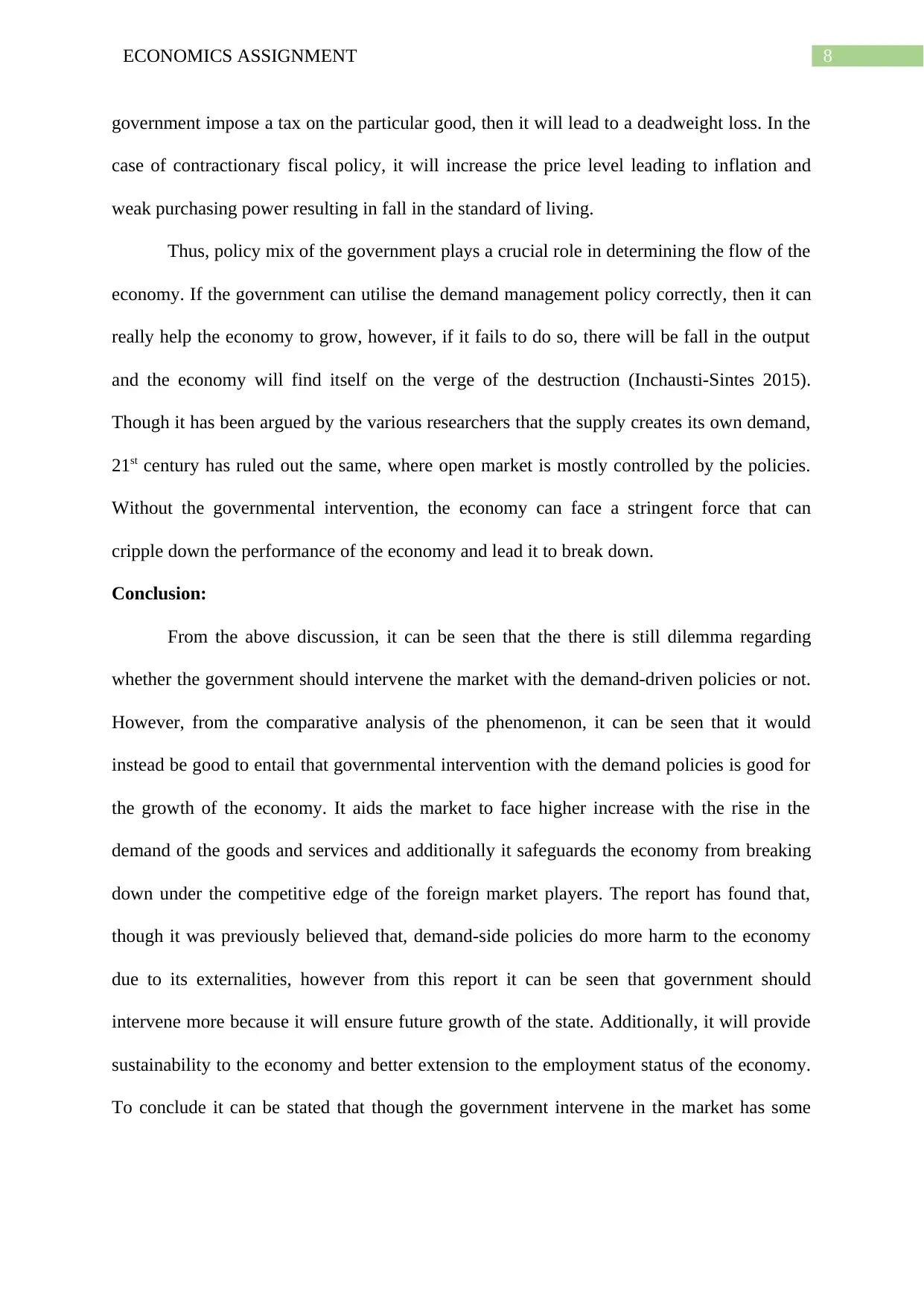
8ECONOMICS ASSIGNMENT
government impose a tax on the particular good, then it will lead to a deadweight loss. In the
case of contractionary fiscal policy, it will increase the price level leading to inflation and
weak purchasing power resulting in fall in the standard of living.
Thus, policy mix of the government plays a crucial role in determining the flow of the
economy. If the government can utilise the demand management policy correctly, then it can
really help the economy to grow, however, if it fails to do so, there will be fall in the output
and the economy will find itself on the verge of the destruction (Inchausti-Sintes 2015).
Though it has been argued by the various researchers that the supply creates its own demand,
21st century has ruled out the same, where open market is mostly controlled by the policies.
Without the governmental intervention, the economy can face a stringent force that can
cripple down the performance of the economy and lead it to break down.
Conclusion:
From the above discussion, it can be seen that the there is still dilemma regarding
whether the government should intervene the market with the demand-driven policies or not.
However, from the comparative analysis of the phenomenon, it can be seen that it would
instead be good to entail that governmental intervention with the demand policies is good for
the growth of the economy. It aids the market to face higher increase with the rise in the
demand of the goods and services and additionally it safeguards the economy from breaking
down under the competitive edge of the foreign market players. The report has found that,
though it was previously believed that, demand-side policies do more harm to the economy
due to its externalities, however from this report it can be seen that government should
intervene more because it will ensure future growth of the state. Additionally, it will provide
sustainability to the economy and better extension to the employment status of the economy.
To conclude it can be stated that though the government intervene in the market has some
government impose a tax on the particular good, then it will lead to a deadweight loss. In the
case of contractionary fiscal policy, it will increase the price level leading to inflation and
weak purchasing power resulting in fall in the standard of living.
Thus, policy mix of the government plays a crucial role in determining the flow of the
economy. If the government can utilise the demand management policy correctly, then it can
really help the economy to grow, however, if it fails to do so, there will be fall in the output
and the economy will find itself on the verge of the destruction (Inchausti-Sintes 2015).
Though it has been argued by the various researchers that the supply creates its own demand,
21st century has ruled out the same, where open market is mostly controlled by the policies.
Without the governmental intervention, the economy can face a stringent force that can
cripple down the performance of the economy and lead it to break down.
Conclusion:
From the above discussion, it can be seen that the there is still dilemma regarding
whether the government should intervene the market with the demand-driven policies or not.
However, from the comparative analysis of the phenomenon, it can be seen that it would
instead be good to entail that governmental intervention with the demand policies is good for
the growth of the economy. It aids the market to face higher increase with the rise in the
demand of the goods and services and additionally it safeguards the economy from breaking
down under the competitive edge of the foreign market players. The report has found that,
though it was previously believed that, demand-side policies do more harm to the economy
due to its externalities, however from this report it can be seen that government should
intervene more because it will ensure future growth of the state. Additionally, it will provide
sustainability to the economy and better extension to the employment status of the economy.
To conclude it can be stated that though the government intervene in the market has some
⊘ This is a preview!⊘
Do you want full access?
Subscribe today to unlock all pages.

Trusted by 1+ million students worldwide

9ECONOMICS ASSIGNMENT
negativities, yet it is essential for the growth of the economy because it will provide them
ample scope to enhance its productivity.
negativities, yet it is essential for the growth of the economy because it will provide them
ample scope to enhance its productivity.
Paraphrase This Document
Need a fresh take? Get an instant paraphrase of this document with our AI Paraphraser
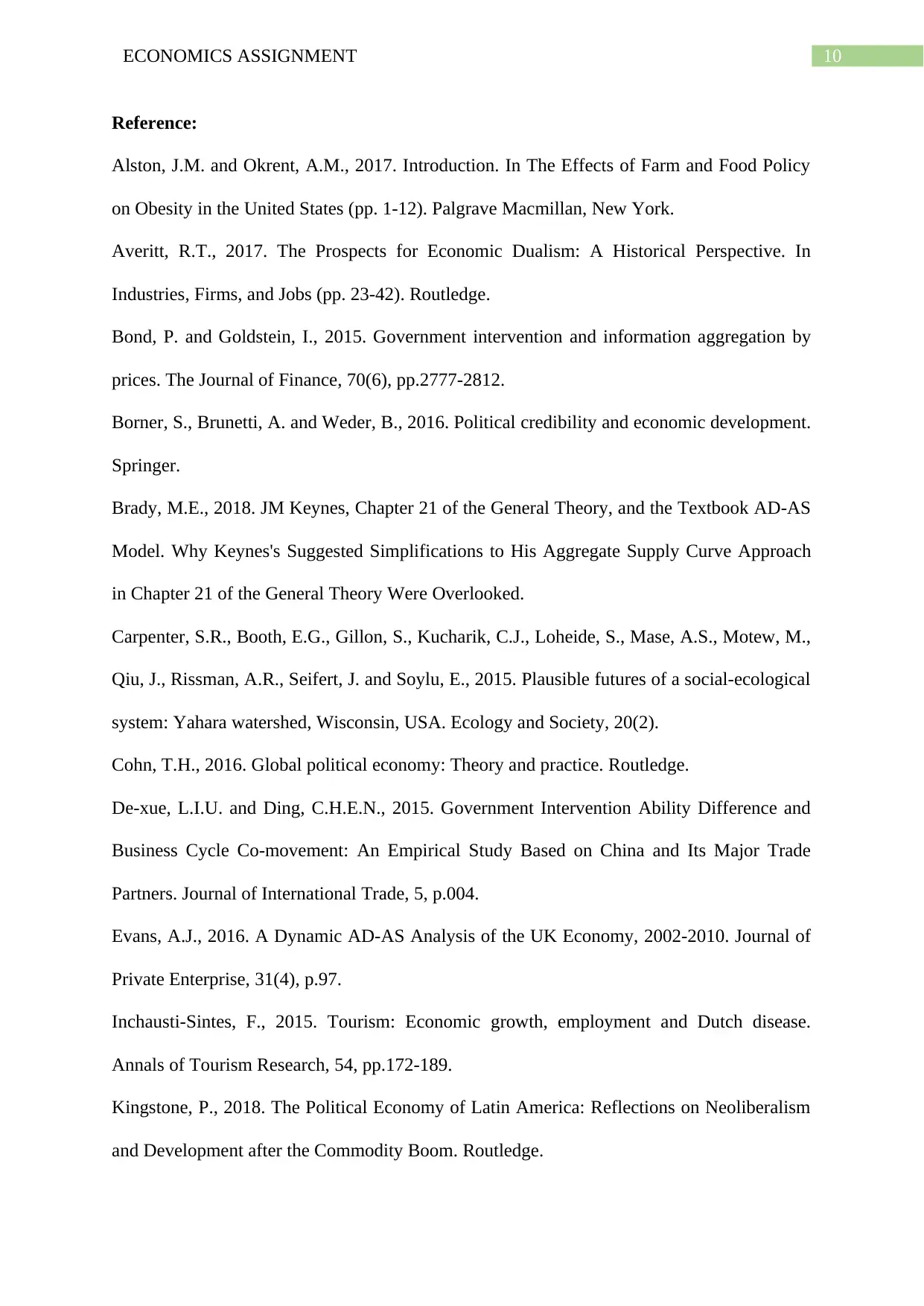
10ECONOMICS ASSIGNMENT
Reference:
Alston, J.M. and Okrent, A.M., 2017. Introduction. In The Effects of Farm and Food Policy
on Obesity in the United States (pp. 1-12). Palgrave Macmillan, New York.
Averitt, R.T., 2017. The Prospects for Economic Dualism: A Historical Perspective. In
Industries, Firms, and Jobs (pp. 23-42). Routledge.
Bond, P. and Goldstein, I., 2015. Government intervention and information aggregation by
prices. The Journal of Finance, 70(6), pp.2777-2812.
Borner, S., Brunetti, A. and Weder, B., 2016. Political credibility and economic development.
Springer.
Brady, M.E., 2018. JM Keynes, Chapter 21 of the General Theory, and the Textbook AD-AS
Model. Why Keynes's Suggested Simplifications to His Aggregate Supply Curve Approach
in Chapter 21 of the General Theory Were Overlooked.
Carpenter, S.R., Booth, E.G., Gillon, S., Kucharik, C.J., Loheide, S., Mase, A.S., Motew, M.,
Qiu, J., Rissman, A.R., Seifert, J. and Soylu, E., 2015. Plausible futures of a social-ecological
system: Yahara watershed, Wisconsin, USA. Ecology and Society, 20(2).
Cohn, T.H., 2016. Global political economy: Theory and practice. Routledge.
De-xue, L.I.U. and Ding, C.H.E.N., 2015. Government Intervention Ability Difference and
Business Cycle Co-movement: An Empirical Study Based on China and Its Major Trade
Partners. Journal of International Trade, 5, p.004.
Evans, A.J., 2016. A Dynamic AD-AS Analysis of the UK Economy, 2002-2010. Journal of
Private Enterprise, 31(4), p.97.
Inchausti-Sintes, F., 2015. Tourism: Economic growth, employment and Dutch disease.
Annals of Tourism Research, 54, pp.172-189.
Kingstone, P., 2018. The Political Economy of Latin America: Reflections on Neoliberalism
and Development after the Commodity Boom. Routledge.
Reference:
Alston, J.M. and Okrent, A.M., 2017. Introduction. In The Effects of Farm and Food Policy
on Obesity in the United States (pp. 1-12). Palgrave Macmillan, New York.
Averitt, R.T., 2017. The Prospects for Economic Dualism: A Historical Perspective. In
Industries, Firms, and Jobs (pp. 23-42). Routledge.
Bond, P. and Goldstein, I., 2015. Government intervention and information aggregation by
prices. The Journal of Finance, 70(6), pp.2777-2812.
Borner, S., Brunetti, A. and Weder, B., 2016. Political credibility and economic development.
Springer.
Brady, M.E., 2018. JM Keynes, Chapter 21 of the General Theory, and the Textbook AD-AS
Model. Why Keynes's Suggested Simplifications to His Aggregate Supply Curve Approach
in Chapter 21 of the General Theory Were Overlooked.
Carpenter, S.R., Booth, E.G., Gillon, S., Kucharik, C.J., Loheide, S., Mase, A.S., Motew, M.,
Qiu, J., Rissman, A.R., Seifert, J. and Soylu, E., 2015. Plausible futures of a social-ecological
system: Yahara watershed, Wisconsin, USA. Ecology and Society, 20(2).
Cohn, T.H., 2016. Global political economy: Theory and practice. Routledge.
De-xue, L.I.U. and Ding, C.H.E.N., 2015. Government Intervention Ability Difference and
Business Cycle Co-movement: An Empirical Study Based on China and Its Major Trade
Partners. Journal of International Trade, 5, p.004.
Evans, A.J., 2016. A Dynamic AD-AS Analysis of the UK Economy, 2002-2010. Journal of
Private Enterprise, 31(4), p.97.
Inchausti-Sintes, F., 2015. Tourism: Economic growth, employment and Dutch disease.
Annals of Tourism Research, 54, pp.172-189.
Kingstone, P., 2018. The Political Economy of Latin America: Reflections on Neoliberalism
and Development after the Commodity Boom. Routledge.

11ECONOMICS ASSIGNMENT
Mehar, A., 2018. Impact of Monetary Policy on Growth and Poverty: Drastic Consequences
of Government Intervention. Journal of Modern Economy, 1.
Miller, P. and Rose, N., 2017. Political power beyond the state: Problematics of government.
In Foucault and Law (pp. 191-224). Routledge.
Pasquariello, P., 2017. Government intervention and arbitrage. The Review of Financial
Studies.
Sumner, S., 2016. The Fed and the Great Recession: How Better Monetary Policy Can Avert
the Next Crisis. Foreign Aff., 95, p.116.
Mehar, A., 2018. Impact of Monetary Policy on Growth and Poverty: Drastic Consequences
of Government Intervention. Journal of Modern Economy, 1.
Miller, P. and Rose, N., 2017. Political power beyond the state: Problematics of government.
In Foucault and Law (pp. 191-224). Routledge.
Pasquariello, P., 2017. Government intervention and arbitrage. The Review of Financial
Studies.
Sumner, S., 2016. The Fed and the Great Recession: How Better Monetary Policy Can Avert
the Next Crisis. Foreign Aff., 95, p.116.
⊘ This is a preview!⊘
Do you want full access?
Subscribe today to unlock all pages.

Trusted by 1+ million students worldwide
1 out of 13
Related Documents
Your All-in-One AI-Powered Toolkit for Academic Success.
+13062052269
info@desklib.com
Available 24*7 on WhatsApp / Email
![[object Object]](/_next/static/media/star-bottom.7253800d.svg)
Unlock your academic potential
Copyright © 2020–2025 A2Z Services. All Rights Reserved. Developed and managed by ZUCOL.





